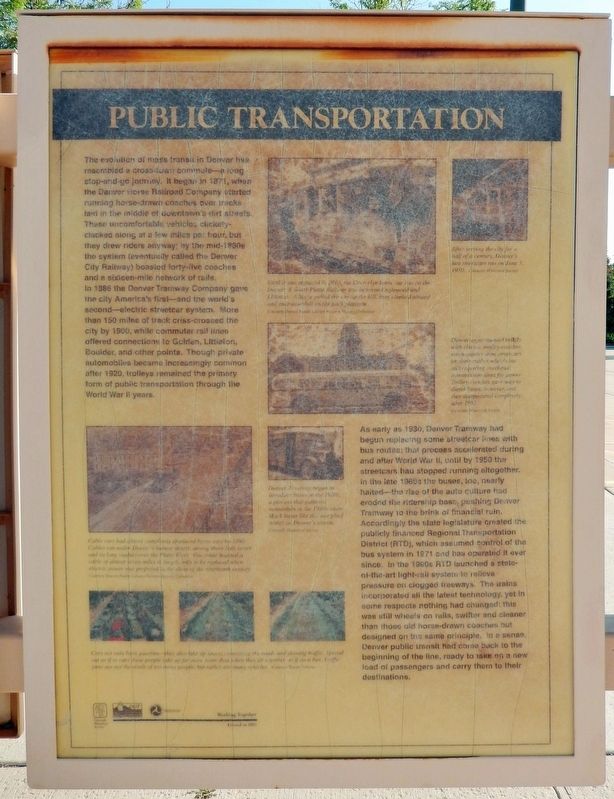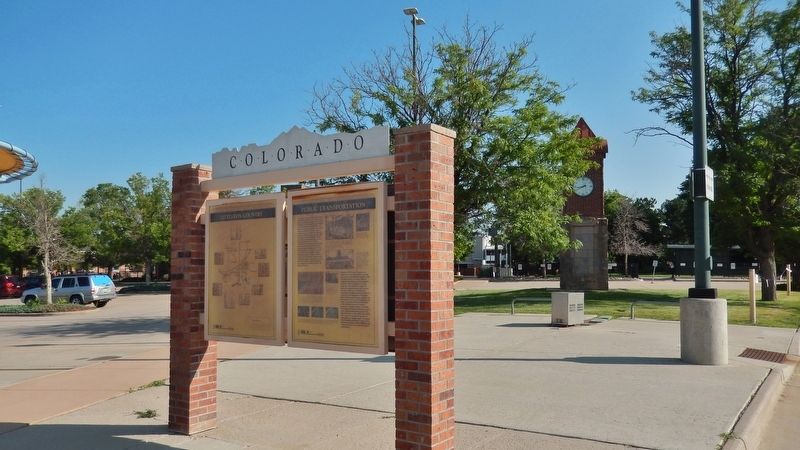Public Transportation
The evolution of mass transit in Denver has resembled a cross-town commute — a long stop-and-go journey. It began in 1871, when the Denver Horse Railroad Company started running horse-drawn coaches over tracks laid in the middle of downtown’s dirt streets. These uncomfortable vehicles clickety-clacked along at a few miles per hour, but they drew riders anyway; by the mid-1880s the system (eventually called the Denver City Railway) boasted forty-five coaches and a sixteen-mile network of rails. In 1886 the Denver Tramway Company gave the city America’s first — and the world’s second — electric streetcar system. More than 150 miles of track criss-crossed the city by 1900, while commuter rail lines offered connections to Golden, Littleton, Boulder, and other points. Though private automobiles became increasingly common after 1920, trolleys remained the primary form of public transportation through the World War II years.
As early as 1930, Denver Tramway had begun replacing some streetcar lines with bus routes; that process accelerated during and after World War II, until by 1950 the streetcars had stopped running altogether. In the late 1960s the buses, too, nearly halted — the rise of the auto culture had eroded the ridership base, pushing Denver Tramway to the brink of financial ruin. Accordingly the state legislature created the
publicly financed Regional Transportation District (RTD), which assumed control of the bus system in 1971 and has operated it ever since. In the 1990s RTD launched a state-of-the-art light-rail system to relieve pressure on clogged freeways. The trains incorporated all the latest technology, yet in some respects nothing had changed: this was still wheels on rails, swifter and cleaner than those old horse-drawn coaches but designed on the same principle. In a sense, Denver public transit had come back to the beginning of the line, ready to take on a new load of passengers and carry them to their destinations.[photo captions]
• Cable cars had almost completely displaced horse cars by 1890. Cables ran under Denver’s busiest streets, among them 16th Street and its long viaduct over the Platte River. One route boasted a cable of almost seven miles in length, only to be replaced when electric power was perfected at the close of the nineteenth century.
• Until it was replaced in 1910, the Cherrelyn horse car ran on the Denver & South Platte Railway line between Englewood and Littleton. A horse pulled the car up the hill, then climbed aboard and rode downhill on the back platform.
• After serving the city for a half of a century, Denver’s last streetcars ran on June 5, 1950.
• Denver experimented briefly with electric trolley-coaches, much quieter than streetcars
• Denver Tramway began to introduce buses in the 1920s, a process that gathered momentum in the 1930s when Mack buses like this one plied routes on Denver’s streets.
• Cars not only burn gasoline — they also take up space, congesting the roads and slowing traffic. Spread out as if in cars these people take up far more room than when they sit together as if on a bus. Traffic jams are not the result of too many people, but rather too many vehicles.
Erected 2003 by Colorado Historical Society; and Colorado Department of Transportation.
Topics and series. This historical marker is listed in these topic lists: Railroads & Streetcars • Roads & Vehicles. In addition, it is included in the Colorado - History Colorado series list. A significant historical year for this entry is 1890.
Location. 39° 36.727′ N, 105° 0.927′ W. Marker is in Littleton, Colorado, in Arapahoe County. Marker can be reached from South Prince Street south of West Alamo Avenue, on the left when traveling south. Marker is located in the RTD Downtown Littleton Station parking lot. Touch for map. Marker is at or near this postal address: 5777 South Prince Street, Littleton CO 80120, United States of America. Touch for directions.
Other nearby markers. At least 8 other
Also see . . .
1. Denver Tramway Company. For more than a decade after Denver was established in 1858, the city was small enough that there was no need for public transportation. That changed after 1870, when the completion of the Denver Pacific and Kansas Pacific. Railroads tied Denver into the national rail network. From a town of fewer than 5,000 residents in 1870, Denver rapidly expanded to a metropolis of more than 35,000 people in 1880 and more than 105,000 in 1890. (Submitted on July 20, 2021, by Cosmos Mariner of Cape Canaveral, Florida.)
2. Denver Tramway (Wikipedia). The Denver Tramway was unusual for a number of reasons. The term "tramway" was generally not used in the United States. The track was 3 ft 6 in narrow gauge, an unusual gauge in the United States, but in general use by railways in Japan, southern Africa, New Zealand, and Australia. The tramway made use of a variety of types of streetcars, including conduit cars (until 1888), cable cars (until 1900), and trolley cars (until 1950). (Submitted on July 20, 2021, by Cosmos Mariner of Cape Canaveral, Florida.)
Credits. This page was last revised on July 20, 2021. It was originally submitted on July 18, 2021, by Cosmos Mariner of Cape Canaveral, Florida. This page has been viewed 173 times since then and 16 times this year. Photos: 1. submitted on July 18, 2021, by Cosmos Mariner of Cape Canaveral, Florida. 2. submitted on July 20, 2021, by Cosmos Mariner of Cape Canaveral, Florida.

